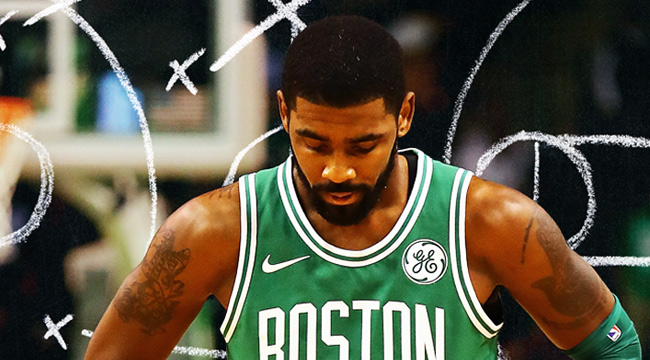
Kyrie Irving couldn’t have gotten off to a better start with the Celtics. After losing the opening two games of the season, Irving has played a commanding role in them winning 13 straight with averages of 20.8 points, 5.0 assists, and 2.9 rebounds per contest. The Celtics have outscored their opponents by 12.1 points per 100 possessions with Irving on the court in those games, putting some concerns to rest about how much the Cavaliers struggled when he had to run the show without LeBron James in the lineup during their three years together in Cleveland.
Part of Irving’s success in that regard can be attributed to Celtics head coach Brad Stevens. Similarly to how Isaiah Thomas benefitted from playing in his system, Irving looks like a completely different player as a member of the Celtics. It’s not necessarily reflected in his per game stats, but he’s starting to do less of what he’s been criticized for time and time again throughout his career in order to get the most out of his new teammates.
The best way to track Irving’s growth is with his shot selection.
According to NBA.com, 55.4 percent of his offense was created in the pick-and-roll and isolation last season compared to 46.6 percent so far this season. While it might not seem like much, the difference opens up more opportunities for Irving to be used as an off-ball threat. Whereas he scored another 19.9 percent of his points from a combination of handoffs, spot-ups, cuts and off of screens last season, Irving has bumped that number up to 34.3 percent in his first season under Stevens.
The distribution isn’t identical to what it was for Thomas in his final season with the Celtics — Irving continues to isolate more than Thomas and Thomas spots-up more often than Irving — but they look like incredibly similar players on paper. It’s then no surprise how well the Celtics have played with Irving in place of Thomas. The same goes for how quickly Irving has developed chemistry with Al Horford, who assisted Thomas more than any other Celtic last season.
Irving has basically made the transition from someone who can score off the ball to someone who is scoring off the ball, which is smart considering how efficient those plays are. According to Nylon Calculus, the two least efficient ways to score are as the ball handler in the pick-and-roll (0.85 PPP) and in isolation (0.88 PPP). Despite the fact Irving was amongst the league’s best at scoring in the pick-and-roll (1.04 PPP) and isolation (1.12 PPP) last season, the areas he has increased his frequency in with the Celtics generally lead to higher quality looks.
Those plays have a tremendous impact on the flow of the game as well. The Cavaliers built an unstoppable offense based on the individual brilliance of James and Irving, a big reason why they were near the bottom of the league in passes made per game last season. The Celtics are different in that they like to move the ball from one side of the court to the other before looking to score, a big reason why they were behind only the 76ers in passes made per game last season.
In general, it means less of the straightforward pick-and-rolls Irving relied on last season:
https://youtu.be/RS8MDNq6fjk
And more player movement to prevent the defense from getting set-up:
https://youtu.be/vzGwyhyTpQ8
Doing so helps space the floor for the Celtics. By giving the ball to Horford instead of having him simply set a screen on Irving every time, it establishes him as a scoring threat away from the basket and draws the opposing big man — usually the best rim protector on the roster — out to the perimeter. It’s not something the Cavaliers could necessarily do with Tristan Thompson (a non-shooter) or Channing Frye (not a creator for himself or others off the dribble).
By relying more on his teammates to put him in scoring position, it also means there’s less pressure on Irving to create for himself in volume. 69.6 percent of his baskets were unassisted last season compared to 56.5 percent for Thomas. In 14 games with the Celtics this season, only 60.2 percent of Irving’s baskets have been unassisted. If he continues at the same rate, Irving will shatter his previous career-low of 67.5 percent.
The majority of those assists have come from Horford, but the Celtics do have a number of players on their roster who can draw enough attention away from Irving to allow him to create for himself or someone else off-ball. It bodes well for Irving’s fit next to Gordon Hayward in particular since he’s one of the best scorers and facilitators at the small forward position.
Based on how frequently Hayward scores as the ball handler in pick-and-rolls, Irving could see his spot-up opportunities increase upon his return to the lineup.
https://youtu.be/pIiphhsCzZI
Irving’s ability to thrive in this sort of role was never in question. Although he didn’t generate many of his points off-ball during his time with the Cavaliers, he still checked out as one of the best in the league at scoring off of screens, handoffs, cut, and spot-ups. The skepticism instead revolved around whether or not he’d be willing to sacrifice some of the opportunities he had in Cleveland to make for an easier transition in Boston.
While the season is still young, the early returns are more encouraging than anyone could’ve expected.






